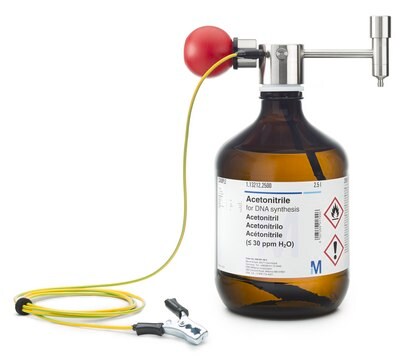1.06018
Methanol
≥99.8% (GC), HPLC grade, suitable for HPLC, LiChrosolv®
Synonym(s):
MeOH, Hydroxymethane, Carbinol, Methyl alcohol
About This Item
410 mmHg ( 50 °C)
97.68 mmHg ( 20 °C)
Recommended Products
Product Name
Methanol, for liquid chromatography LiChrosolv®
grade
HPLC grade
isocratic
Quality Level
vapor density
1.11 (vs air)
vapor pressure
128 hPa ( 20 °C)
410 mmHg ( 50 °C)
97.68 mmHg ( 20 °C)
product line
LiChrosolv®
Assay
≥99.8% (GC)
form
liquid
autoignition temp.
725 °F
potency
5628 mg/kg LD50, oral (Rat)
17100 mg/kg LD50, skin (Rabbit)
expl. lim.
36 %
technique(s)
HPLC: suitable
impurities
≤0.0002 meq/g Acidity
≤0.0002 meq/g Alkalinity
≤0.03% Water
evapn. residue
≤3.0 mg/L
color
APHA: ≤10
transmittance
225 nm, ≥50%
240 nm, ≥80%
265 nm, ≥98%
refractive index
n20/D 1.329 (lit.)
kinematic viscosity
0.54-0.59 cSt(20 °C)
bp
64.7 °C (lit.)
mp
−98 °C (lit.)
transition temp
flash point 9.7 °C
density
0.791 g/mL at 25 °C (lit.)
format
neat
storage temp.
2-30°C
SMILES string
CO
InChI
1S/CH4O/c1-2/h2H,1H3
InChI key
OKKJLVBELUTLKV-UHFFFAOYSA-N
Looking for similar products? Visit Product Comparison Guide
General description
Application
Featured in method development of:
- Benazepril - USP Method Benazepril RS
- Betamethasone - USP Method Betamethasone Valerate Assay
- Irbesartan - USP Method Irbesartan Assay
- Lamivudine - USP Method Lamivudine RS
- Lansoprazole - USP Method Lansoprazole RS
- Levofloxacin - USP Method Levofloxacin RS - USP Method Levofloxacin Assay
- Nifedipine - USP Method Nifedipine RS - USP Method Nifedipine Assay
- Pharmacopoeia Monograph Methods - HPLC and UHPLC methods for Regulated Drug Analysis
- Pioglitazone - USP Method Pioglitazone HCl RS - USP Method Pioglitazone HCl Assay
Features and Benefits
- suitability tested and specified for UHPLC-MS and UHPLC-UV: for analytical flexibility
- specified quality in positive and negative in positive and negative electrospray ionization (ESI) and atmospheric-pressure chemical ionization-mass spectrometry (APCI-MS) for lowest detection limits and confidence in analyses for all important MS modes (test 1)
—ESI/APCI (+) < 2 ppb
—ESI/APCI (-) < 10 ppb - lowest impurity profile: for interference-free baselines (test 2)
- microfiltered through 0.2 μm filter (test 3) to provide:
—A long lifespan to filters and mechanical parts of HPLC systems
––reduced risk of column clogging - packaged in borosilicate glass bottles for minimized metal ion contaminations
- lowest levels of trace metal impurities for a minimum metal ion adduct formation
—<5 ppb - lowest level of polyethylene glycol (PEG) impurities in UHPLC-MS solvent lineup (PEG S/N signal-to-noise-ratio < 50)
Preparation Note
Analysis Note
Identity (IR): conforms
Evaporation residue: ≤ 3.0 mg/l
Water: ≤ 0.03 %
Color: ≤ 10 Hazen
Acidity: ≤ 0.0002 meq/g
Alkalinity: ≤ 0.0002 meq/g
Transmission (at 225 nm): ≥ 50 %
Transmission (at 240 nm): ≥ 80 %
Transmission (from 265 nm): ≥ 98 %
Filtered by 0.2 µm filter
Other Notes
Legal Information
Not finding the right product?
Try our Product Selector Tool.
Signal Word
Danger
Hazard Statements
Precautionary Statements
Hazard Classifications
Acute Tox. 3 Dermal - Acute Tox. 3 Inhalation - Acute Tox. 3 Oral - Flam. Liq. 2 - STOT SE 1
Target Organs
Eyes,Central nervous system
Storage Class Code
3 - Flammable liquids
WGK
WGK 2
Flash Point(F)
49.5 °F - closed cup
Flash Point(C)
9.7 °C - closed cup
Certificates of Analysis (COA)
Search for Certificates of Analysis (COA) by entering the products Lot/Batch Number. Lot and Batch Numbers can be found on a product’s label following the words ‘Lot’ or ‘Batch’.
Already Own This Product?
Find documentation for the products that you have recently purchased in the Document Library.
Customers Also Viewed
Articles
HPTLC separation followed by UV detection of the bitter acid content in various hop samples.
A new HPTLC method to detect adulteration of essential oils is presented along with a range of newly added essential oil reference materials for authenticity analysis.
Protocols
Following GB method for Vitamin A and Vitamin E as it is written with a 250 x 4.6 mm Ascentis® Express C30 column gives baseline resolution between the critical pair (gamma-, and beta-tocopherol; peaks 3 and 4).
Folic acid or folate is classified as a B vitamin (B9). Folic acid is synthetically produced, and used in fortified foods and supplements. Folate is converted by humans to dihydrofolate (dihydrofolic acid), tetrahydrofolate (tetrahydrofolic acid), and other derivatives, which have various biological activities.
In the present study we demonstrate compliance of silica gel 60 F254 HPTLC plates with USP requirements, and how HPTLC plates are suitable for the Sildenafil citrate-Limit of Imidazole test.
Qualitative Thin Layer Chromatography Analysis of Flavonoids and Quantification of Terpene Lactones in Ginkgo Biloba Extracts and Tablets
Related Content
This application note illustrates how it is possible to set-up an assay method for Lopinavir and Ritonavir tablets.
Our team of scientists has experience in all areas of research including Life Science, Material Science, Chemical Synthesis, Chromatography, Analytical and many others.
Contact Technical Service








